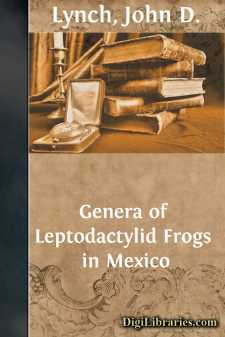Categories
- Antiques & Collectibles 13
- Architecture 36
- Art 48
- Bibles 22
- Biography & Autobiography 813
- Body, Mind & Spirit 142
- Business & Economics 28
- Children's Books 17
- Children's Fiction 14
- Computers 4
- Cooking 94
- Crafts & Hobbies 4
- Drama 346
- Education 46
- Family & Relationships 57
- Fiction 11829
- Games 19
- Gardening 17
- Health & Fitness 34
- History 1377
- House & Home 1
- Humor 147
- Juvenile Fiction 1873
- Juvenile Nonfiction 202
- Language Arts & Disciplines 88
- Law 16
- Literary Collections 686
- Literary Criticism 179
- Mathematics 13
- Medical 41
- Music 40
- Nature 179
- Non-Classifiable 1768
- Performing Arts 7
- Periodicals 1453
- Philosophy 64
- Photography 2
- Poetry 896
- Political Science 203
- Psychology 42
- Reference 154
- Religion 513
- Science 126
- Self-Help 84
- Social Science 81
- Sports & Recreation 34
- Study Aids 3
- Technology & Engineering 59
- Transportation 23
- Travel 463
- True Crime 29
Genera of Leptodactylid Frogs in Mexico
by: John D. Lynch
Description:
Excerpt
INTRODUCTION
According to the most recent review of the Mexican amphibian fauna (Smith and Taylor, 1948), six genera of leptodactylid frogs occur in México. One other genus, Pleurodema, occurs in Lower Central America. Smith and Taylor recognized one species of Engystomops, 28 of Eleutherodactylus, three of Leptodactylus, eight of Microbatrachylus, 12 of Syrrhophus, and five of Tomodactylus. Subsequent to the publication of their checklist of the Mexican amphibia (1948), numerous taxonomic changes have been proposed. Many species of Eleutherodactylus have been added to the fauna, either through the extension of their recorded ranges into México from Guatemala or by the recognition of species unknown in 1948, whereas some nominal species have been synonymized. Microbatrachylus has been regarded as synonymous with Eleutherodactylus (Lynch, 1965); four species of Microbatrachylus currently are regarded as valid (Duellman, 1961, Lynch, 1965). Syrrhophus was revised in part by Duellman (1958) and Firschein (1954), and a species of Tomodactylus transferred to Syrrhophus by Dixon (1957), who redefined Tomodactylus and added more species to the genus.
Since beginning my studies of the Mexican leptodactylids in 1962, I have become acutely aware of difficulties involved in defining the genera. A revision of Eleutherodactylus and a review of Syrrhophus are nearing completion, but prior to their publication it is desirable to redefine the genera of the Mexican leptodactylids, and in so doing recognize an heretofore unnamed genus. The definitions of Eleutherodactylus and Leptodactylus may need to be altered in the future, since both are widespread in South America and occur in the West Indies. Their definitions as given here are as precise as present knowledge permits. Syrrhophus and Tomodactylus are small assemblages that occur only in southwestern United States, México, and Guatemala.
Taylor (1952) synonymized Engystomops with Eupemphix which, although related, should be regarded as generically distinct (Gallardo, 1965). Perhaps the most conservative classification is that of Myers (1962) who, without published evidence, combined Eleutherodactylus, Syrrhophus, and the South American Lithodytes in a single genus.
The major problem for students working with the Mexican leptodactylids has not been the separation of Engystomops or Leptodactylus from other genera but the separation and definition of the eleutherodactyline frogs currently placed in three genera, Eleutherodactylus, Syrrhophus, and Tomodactylus. As will be shown in this paper, these are more conveniently placed in four genera. Once a fourth genus is recognized, certain phylogenetic problems disappear and a reasonable zoogeographic interpretation is possible for Middle American leptodactylid distribution.
In México and northern Central America approximately 55 species of eleutherodactyline frogs (Eleutherodactylus, Syrrhophus, and Tomodactylus) are known. Four genera can be recognized on the basis of the nature of inguinal glands, morphology of the hands and feet, and certain osteological features.
...


